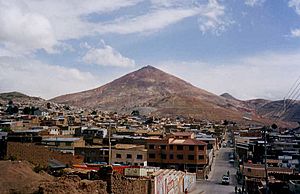Cordillera Central (Bolivia) facts for kids
The Cordillera Central is a huge mountain range in Bolivia. Think of it as a giant natural wall that divides the country's main river systems. It also has some of Bolivia's tallest mountains! This area is super rich in valuable minerals. It stretches from a mountain called Chawpi Urqu in the north all the way down to Zapaleri in the south, which sits right on the border with Chile and Argentina.
The Cordillera Central is divided into three main parts:
Contents
Northern Section: The Royal Mountains
This part is also known as the Cordillera Real. It's home to some of Bolivia's most famous and highest peaks. Mountains like Illimani, Illampu, Janq'u Uma, Mururata, and Huayna Potosí are all found here. Each of these giants stands taller than 6,000 meters (about 19,685 feet)! This section is also special because it has the world's highest weather observatory on Chacaltaya mountain. Plus, you can find some of the highest ski slopes on Earth here, perfect for winter sports!
Central Section: Mining History
The middle part of the Cordillera Central includes the famous Sumaq Urqu mountain, also known as the Cerro Rico of Potosí. This mountain is well-known for its rich history of silver mining. The Potosí mountain range and the "Paso de Condor" train station are both located at a high elevation of 4,288 meters (about 14,068 feet) in this section.
Southern Section: Tin Deposits
The southern part of the Cordillera Central is famous for its many minerals, especially large amounts of tin. The highest point in this section is Zapaleri mountain. It's an important peak because it sits right on the border where Bolivia meets Chile and Argentina.
The Cordillera Central is also located between two other major mountain ranges: the Cordillera Occidental (Western Range) and the Cordillera Oriental (Eastern Range).
Learn More
If you want to learn more about the Cordillera Central in Spanish, you can check out this link for kids:



